In This Issue
The opinions, beliefs and viewpoints expressed in this publication are those of the authors. They do not necessarily reflect the opinions, beliefs, viewpoints or official policies of Autism Society Alberta. |
|
|
Town Hall
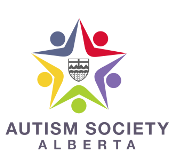
Autism Alberta’s Family Resource Centres are so very excited to announce their first-ever Town Hall! We can't wait to hear from you!!
Step 1 - Fill out the online survey here.
Step 2 - Register to attend the Virtual Town Hall on Wednesday, March 9th at 6:30pm here.
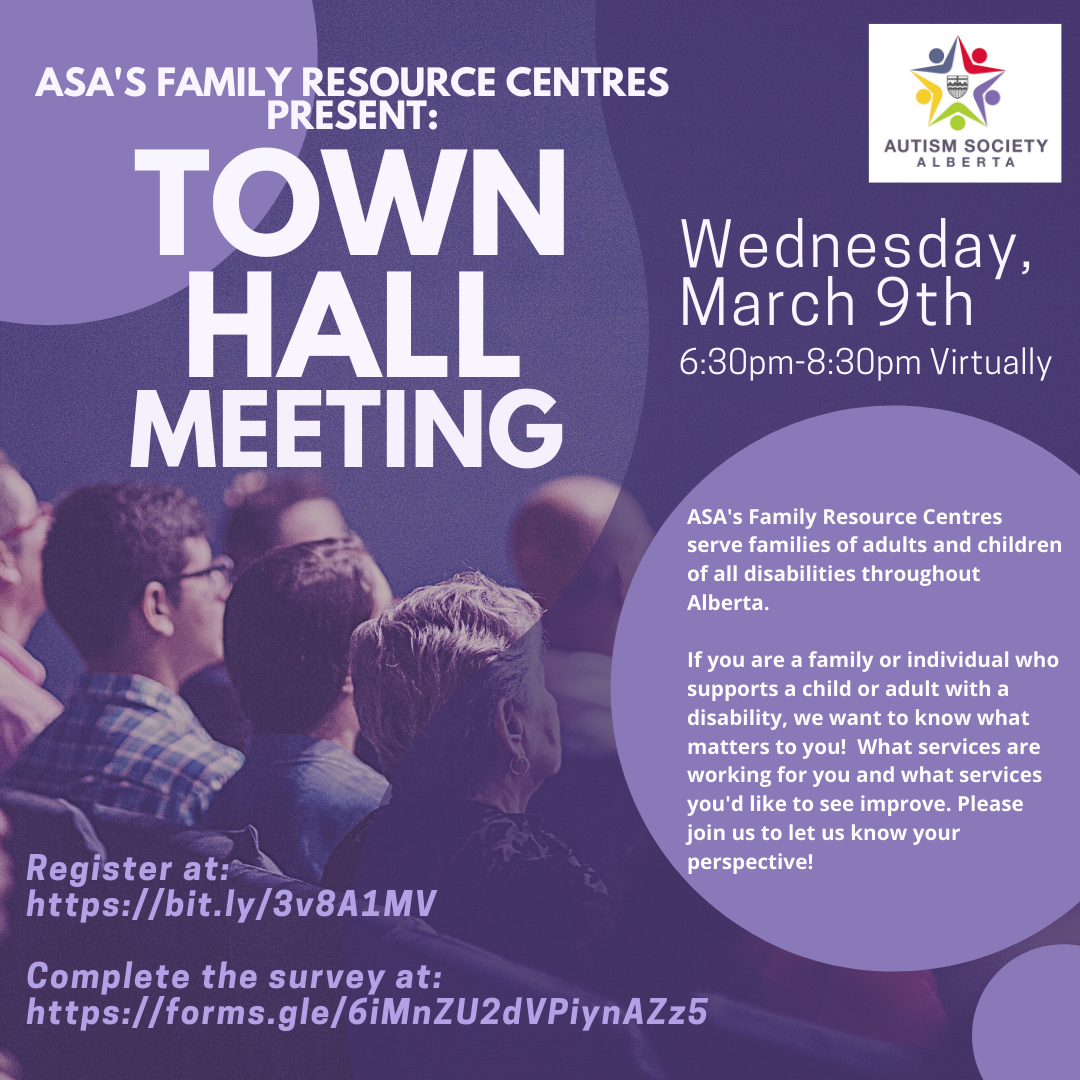
|
|
|
Special Needs Schools in Alberta
Kitty Parlby
I think most of us would agree that having the right to inclusive education is important. This option allows our autistic children (and those with other disabilities) to go to a ‘regular’ school, hopefully with the support needed. There are also mainstream schools that have some special needs programming, or even a special needs classroom. And indeed, this is the route many parents aim for. But education is not one-size-fits-all for anyone, including those with disabilities. What if attending your local school is not a good fit, for whatever reason? It’s great to have options!
After being asked about this subject several times this month, I decided to compile a list of special needs schools in Alberta. I have focused on schools that have at least some classes between Grade 1 and Grade 12. My list below is not exhaustive; there are more, but it’s a start. Some are private schools, and some are special needs schools within a public school division. Also, some are autism-specific, some are pan-disability.
There is one that I’d like to give special mention to. Although Calgary Quest  (listed below) has a physical school, it also has the HUB program. This is the FIRST distance learning program in Alberta for students (grades 1 - 12) with moderate to severe disabilities. You don’t have to live in Calgary; YOU CAN ATTEND HUB FROM ANYWHERE IN ALBERTA. For some families, this will be a welcome option. To find out more, start here. (listed below) has a physical school, it also has the HUB program. This is the FIRST distance learning program in Alberta for students (grades 1 - 12) with moderate to severe disabilities. You don’t have to live in Calgary; YOU CAN ATTEND HUB FROM ANYWHERE IN ALBERTA. For some families, this will be a welcome option. To find out more, start here.
Having said that, here we go!
LOCATED IN CALGARY
Calgary Quest School - Website: https://www.calgaryquestschool.com/
This is a pan-disability school that “employs a high ratio of staff who provide each student with support and guidance for learning and growing at their own pace. Our multidisciplinary team of teachers, therapists, and support staff work together to meet the needs of each student and allow them to reach their full potential.”
Grades 1-12
Phone: (403) 253-0003
Email: info@calgaryquestschool.com
Christine Meikle School – Website: https://school.cbe.ab.ca/school/christinemeikle/Pages/default.aspx
A pan-disability school that offers “A variety of specialized programs, Individualized programming, home care nursing support (LPN), access to SSIL Therapy Team, vocational programming, adaptive and augmentative communication program, and a music therapy program.”
Grades 5-12
Phone: 403-817-3524
Email: christinemeikle@cbe.ab.ca
Janus Academy - Website: http://www.janusacademy.org
This is an autism-specific school that “supports a low student-to-teacher ratio. The program provides a major emphasis in three core areas; development of language and communication skills, the expansion of learner skills and academics, and the development of socially appropriate behaviour and classroom skills.”
Grades 1-12
Phone: (403) 262-3333
Email: janus.contact@janusacademy.org
New Heights School - Website: http://www.newheightscalgary.com/
This is a mostly autism-specific school that “works with our students and their families to focus on their individual strengths while we implement strategies to overcome emotional challenges, develop positive peer relationships, and achieve academic success.”
Grades K-12
Phone: (403) 240-1312
Email: info@newheightscalgary.com
Renfrew Educational Services - Website: http://www.renfreweducation.org
A pan-disability school that “with child development facilitators, on-site therapists and parents, develop individualized programs for each student using a variety of best practice tools and resources. Music, art, physical fitness, and life skills are vital components of our programming. “ using a variety of best practice tools and resources. Music, art, physical fitness, and life skills are vital components of our programming. “
Grades K-6
Phone: (403) 291-5038
Email: renfrew@renfreweducation.org
The Third Academy - Website: http://thirdacademy.ca/
A pan-disability school that “offers a well-balanced, individualized, integrated, and intensive program for each student, designed to prepare them for re-entry into their community school as quickly as possible.”
Grades 1-12
Phone: (403) 288-5335
Email: info@thirdacademy.ca
LOCATED IN EDMONTON
Elves Special Needs Society – Website: http://www.elves-society.org/programs-2/grades-1-12/
A pan-disability school for children with severe delays, where “classrooms are multi-aged and grouped according to abilities. The secure facility provides a large indoor area for gross motor activities and exercise, along with access to an adapted kitchen and laundry room.”
Grades 1-12
Phone: (780) 454-5310 ext. 236
Email: sw3@elves-society.com
E2 Academy – Website: https://www.e2academy.com/
A school for ‘twice exceptional’ (2e) learners. This means students who are gifted intellectually, but also have learning differences such as ADHD, ASD, Dyslexia, Visual/Auditory/Sensory processing disorders, or anxiety.
Grades K-12
Phone: (780) 438-0824
Email: info@e2academy.com
Unlimited Potential Community Services (UP) - Website: https://upcs.org/services/educational-programs/
They have 4 schools in Edmonton and the surrounding area for severely delayed autistic children, and those with other diagnoses. They are “able to provide small classrooms with a 3:1 student to staff ratio where students get the structure and supports to find success in school.”
- Thomas More Academy (Edmonton)
- Phoenix Academy (Edmonton)
- Columbus Academy (Stony Plain)
- Bright Bank Academy (Stony Plain area)
Phone: 780-440-0708 Ext 224
Email: kmilliken@upcs.org
LOCATED IN OTHER CITIES/TOWNS
Herald School – Medicine Hat - Website: https://herald.mhpsd.ca/
“Staff and students seek to develop an optimal learning environment that is Safe, Welcoming, Achievement, Responsible, and Mindful. Opportunities are provided for students to develop skills for lifelong learning helping them to become the best they can be.”
Grades 7-12
Phone: 403-526-4477
Email: herald@sd76.ab.ca
Horizon School – Olds – Website: https://www.horizonschool.ca/
“At Horizon School, there is a rich history and a long tradition of providing quality educational programming for students with a variety of specialized needs, including communication difficulties, social-emotional behavioural needs, and developmental delays.”
Grades: 1-12
Phone: 403-556-6310
Email: horizon.school@cesd73.ca
Parkland School – Red Deer - Website: http://www.parklandschool.org/
The school operates specialized programming designed to meet the educational needs of children and young adults with cognitive and physical disabilities.
Grades 1-12
Phone: 403-347-3911
Email: prkland@shaw.ca
As you can see, there are a variety of choices ranging from full to partial inclusion, as well as both in-person and online special needs schools. With a little research and a school visit, I am hopeful that you will find a good-fit school for your child and your family!
Kitty Parlby is the mother of an autistic young adult, and a former special needs Educational Assistant. Currently she is an autism speaker and consultant with Autism Inspirations, and also works as a Family Resource Coordinator for Autism Society Alberta.
|
|
|
Centre for Autism Services Alberta

It’s a New Year! Thinking about getting a job? Our EmploymentWorks program offers employment readiness training and job sampling work experience for individuals with a disability, including but not limited to ASD. With in-person, online, and hybrid streams available, there’s an option that suits YOU! To inquire and to register, send us an email at EmploymentWorks (employmentworks@centreforautism.ab.ca). Start your job search today!
Upcoming Workshops
Supporting Autism in the Classroom - For Educational Assistants
March 3 & 4, 2022 from 9:00 am to 4:00 pm MST
This two-day workshop will provide Educational Assistants with information, tools, and strategies to better support autistic students in the classroom. You will learn best practices to encourage the independence and participation of students with autism in the classroom. For more information and to register, click HERE.
Supporting Autism in the Classroom - For teachers and administrators
March 20 & 21, 2022 from 9:00 am to 4:00 pm MDT
This two-day workshop will provide teachers and administrators (e.g., learning coaches, principals, etc.) with information, tools, and strategies to promote inclusion. You will learn how best to support the independence and participation of students with autism in the classroom.
For more information and to register, click HERE.
Social Skills and Play Dates
March 23, 2022 from 6:00 pm – 8:00 pm MDT
This FREE workshop will explore strategies to teach a variety of social skills, how to set up a play date, and how to best support a play date. Parents will leave with increased confidence in helping their child to meet the social and emotional needs gained through making friends and connecting with other kids. For more information and to register, click HERE.
|
|
|
The Extra Costs of Extraordinary Parenting
Karla Power
Kids are expensive! I’m sure we can all agree on that, but I would like to shed some light on the extra costs that go along with parenting a child or children with extraordinary needs. This list is by no means complete, and although many of these extra costs occur for my family, some of them are costs that I have learned about through other moms who have kids with different needs than my own.
Childcare: Most special needs children require 1:1 care or a smaller ratio than the typical daycare can provide. That often comes at an extra cost.
Respite: Along with childcare, respite is another service that special needs families often utilize. Sometimes the family needs more respite than is covered by their FSCD (Family Support for Children with Disabilities) contract, and if a private worker is hired, the parents pay out of pocket before being reimbursed.
Private Speech Therapy: For parents like us who want to supplement the speech therapy that their children receive from school, private speech therapy is an additional cost that is only sometimes covered by health plans.
Other Therapies: Other private therapies such as occupational therapy, physical therapy, and counseling for both children and parents definitely add up!
Diapers/Wipes: Toilet training often happens years longer than their typical peers, which can mean paying for daytime diapers and wipes until a child is 7 or 8, and diapers for nighttime sometimes longer.
Home repairs: Although most kids can be rough on furniture and such, there have been some incidents in our home with chewing, ripping, climbing and bodily fluids that have led to some pricey home repairs, such as replacing blinds and ripping up carpet.
Cleaning: There never seems to be enough time to clean! Some families invest in a house cleaner to stay on top of it, while others stock up on Lysol wipes and laundry detergent, for when they get a few spare moments to tend to something other than their children.
Clothing: Clothing needs to be replaced more often due to toileting accidents, excessive chewing, wear and tear, and other messes. Some 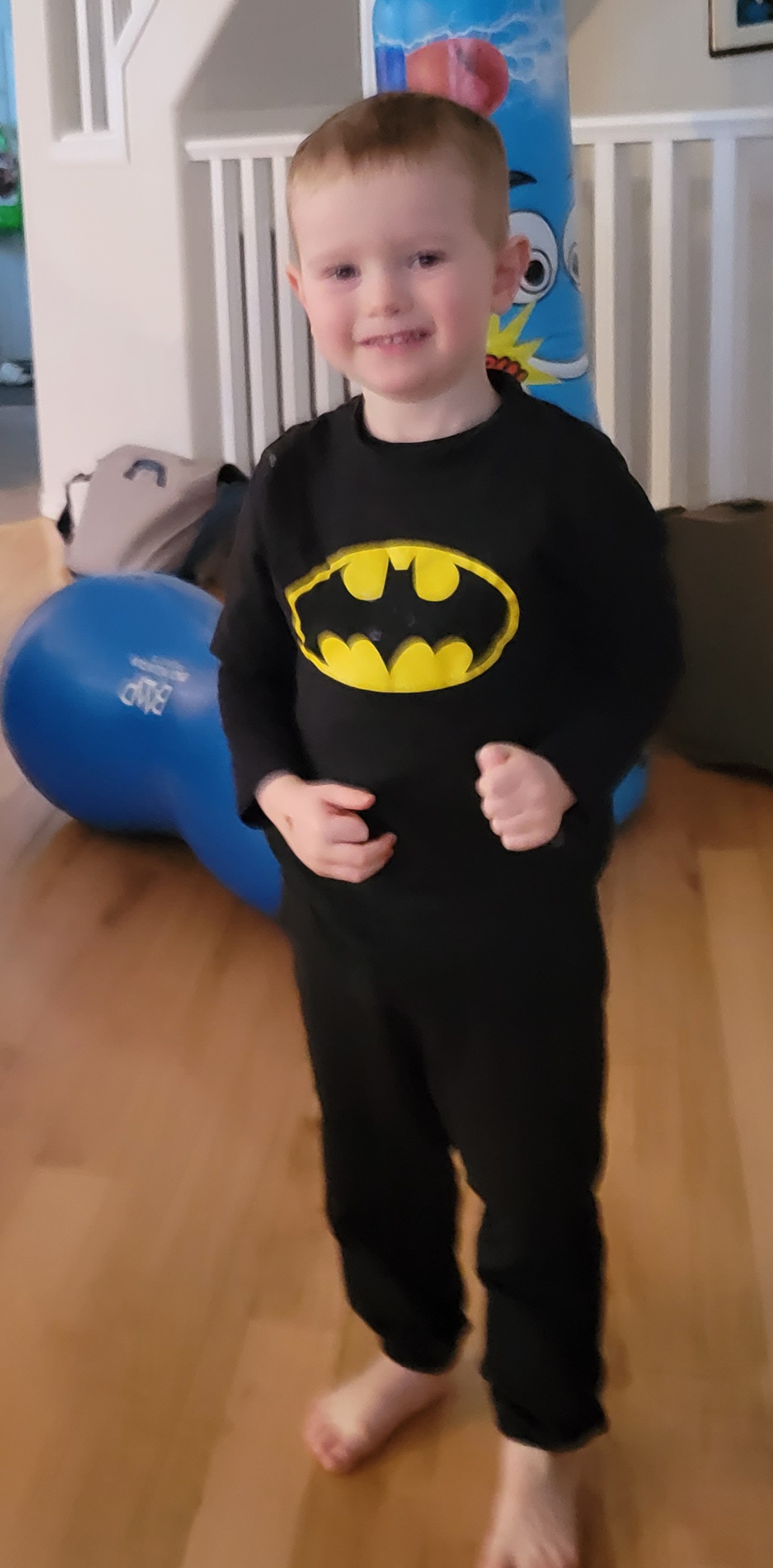 clothing that is required needs to be specially ordered, such as sleepers and onesies for older children who make messes if given access to their diapers at night. Specialty clothing comes with a rather large price tag! clothing that is required needs to be specially ordered, such as sleepers and onesies for older children who make messes if given access to their diapers at night. Specialty clothing comes with a rather large price tag!
Adaptive equipment: Speaking of large price tags, it seems that any adaptive equipment or tools that are marketed as “sensory” or “special needs” often has the price jacked up! But alas, these are things our children need, so we pay the price.
Travel: Children with special needs may need to travel for medical appointments, sometimes even to receive sedation to get a cavity filled in a timely manner.
Medical expenses: Other medical expenses include paying for medications and medical equipment that is not always covered by insurance.
Safety: Safety is a huge concern for many special needs parents, leading them to invest in extra bed rails, locks, alarm systems, monitors, personalized tracking devices, and car seats for their children.
Accessibility: For children with mobility concerns, adaptive equipment can sometimes mean big-ticket items such as wheelchair-accessible vehicles. Even specialized footwear, braces, walkers, and wheelchairs can add up, as they need to be replaced as the child grows.
Food/Supplements: Diets are often quite restrictive for those with sensory issues, leading parents to stock up on those preferred foods. Picky eating can also mean the child’s doctor may recommend further supplements and vitamins for nutrition. Other times, there can be food allergies, which can mean a special diet, such as gluten-free, which can be expensive.
Activities: My children are quite active and need to get their energy out throughout the day, in order to get a good night’s sleep. That is why we are often seen out and about on the weekends at playgrounds. In the winter, we pay admission to indoor playgrounds and the pool to keep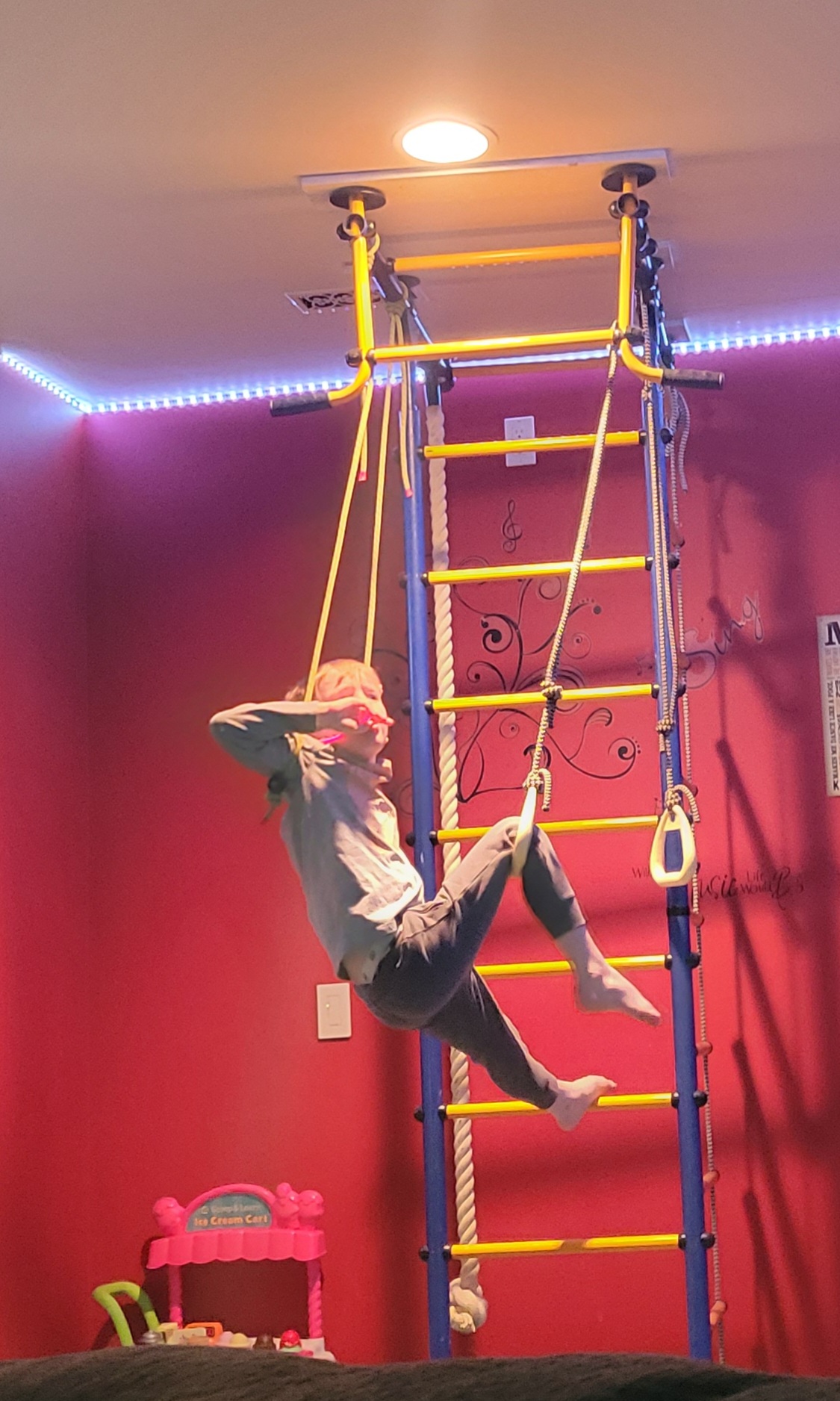 them active. During Covid, we even purchased a swing set when the playgrounds were closed, in order to keep the boys active. them active. During Covid, we even purchased a swing set when the playgrounds were closed, in order to keep the boys active.
Gross/fine motortools: Our basement is pretty much like an indoor playground with a swing, trampoline, climber/slide combo, and a trapeze set. We invested in these items to help the boys work on their gross motor skills and keep them active. We have also bought countless items such as weighted utensils, and toys to promote their fine motor practice.
Sensory items: Many children require tools for their sensory needs such as weighted blankets/vests, noise-canceling headphones, chewelry, calming lights, sound machines, and fidgets to help them regulate throughout the day.
Communication: Besides speech therapy, communication tools and resources also have an additional cost. Applications for iPads, and the iPads themselves, are quite costly. Even the printing and laminating used to create PEC (Picture Exchange Communication) cards adds up.
Resources/Courses: When receiving a diagnosis, parents often want to find out as much as they can to help their child. We have bought many books about Autism, and taken several courses as well.
Work: A lot of Moms that I know who have kids with extra needs do not work. Appointments, meetings, and getting their child to and from school is a full-time job. Although my husband and I both work, I decided to take a pay cut for the last two years, so that I could carve out time in my schedule for appointments and meetings for the boys.
Time: Parents of children with extraordinary needs invest a lot of time in their children, to try to give them the best life possible. That can mean putting their own needs to the side. Things like date nights and self-care are big investments that don’t happen as often as we would like. I have only been away from my 3-year-old overnight once, during a teachers’ convention, because without family here, the cost of 24-hour childcare for two special needs kids is just too much!
This list may seem like a list of complaints to some, but my hope is that it is an eye-opening read. I acknowledge that all kids come with costs (I see you, hockey and dance moms!). However, no matter the cost associated with raising our boys, the benefits always outweigh the costs, and raising two happy boys is priceless!
|
|
|
Kevin Mulligan Wins an Award!
Kevin Mulligan is a Senior Building Operator for Dream, one of Canada’s leading real estate companies. He is also a volunteer board member at Autism Calgary Association and an Autism Alberta facilitator for the autistic adult support group.
Recently, Kevin was one of four exceptional employees across Canada to win an award from Dream. He was nominated by a coworker and recognized for many attributes, including his commitment to the community, hard work, and serving as a role model and mentor to his colleagues.
His award included a $1,000 donation to a charity of his choice. “The reason I chose Autism Calgary Association is because I am privileged to work with them closely and see the need they fulfill first hand. I work with autistic adults and am blessed to be able to share some of the knowledge I acquired over my working life. There is so much potential in the field of autism services, with so far yet to go. This is my cause and I am honored to be able to help,” says Kevin.

Thank you, Kevin for your passion and dedication to our community!
|
|
|
Autism Edmonton Celebrates World Autism Awareness Day
Only ONE day after World Autism Awareness Day, join our partner, Autism Edmonton, as they celebrate neuro-diverse Edmontonians and spread awareness of autism alongside the Edmonton Oil Kings! The first 50 individuals with a child, youth, or adult on the autism spectrum will get to participate in the Honour Guard Experience (if desired). This experience will be a few rows in Rogers Place where flags and other swag will be given, and people have the opportunity to be shown on the jumbotron! Please scan the QR code on the poster above or click here to get your tickets!
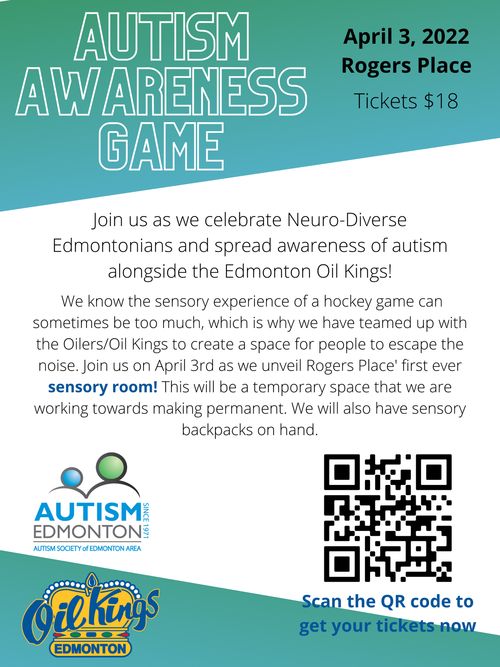
|
|
|
Nathan’s Autism Spectrum Superpowers!
Nicole Burnett
Nathan’s Autism Spectrum Superpowers is an illustrated children’s book 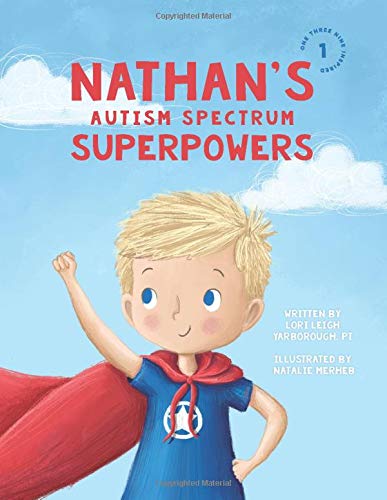 written by Lori Leigh Yarborough, that is beautifully and descriptively written, placing positive emphasis on the unique abilities that accompany an ASD diagnosis. In the book, Nathan takes us through what it means to have Autism Spectrum Disorder. He assigns fantastic superpower labels to his unique abilities, like his “supersonic hearing” where he describes his sensitivity to loud noise, and his “actual factual literal power” where he describes his ability to take everything literally. written by Lori Leigh Yarborough, that is beautifully and descriptively written, placing positive emphasis on the unique abilities that accompany an ASD diagnosis. In the book, Nathan takes us through what it means to have Autism Spectrum Disorder. He assigns fantastic superpower labels to his unique abilities, like his “supersonic hearing” where he describes his sensitivity to loud noise, and his “actual factual literal power” where he describes his ability to take everything literally.
I like this book for two reasons. First, the book is written for parents to read with their ASD children and leaves an opportunity for children to give their own unique abilities superpower labels. The author takes a positive tone, encouraging children to appreciate their differences, while also emphasizing that not everyone is going to understand them. The author also uses positive language like “abilities” and “challenges” in place of the more clinical terms that we are used to hearing like “behaviour” or “symptom.”
Second, I like this book because it is also designed to be read with “friends,” perhaps siblings, or in a classroom setting. The author features several sections labeled as “helpful hints for friends.” These excerpts give tips on how to help their ASD friend in situations where their ASD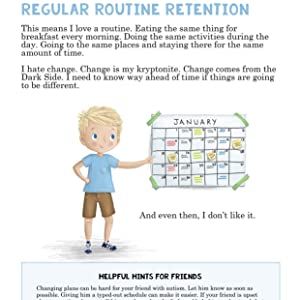 superpowers take over. For example, when Nathan’s supersonic hearing overwhelms him, the helpful hint suggests a friend could give Nathan a pair of noise-canceling headphones, or take him to a quiet space. superpowers take over. For example, when Nathan’s supersonic hearing overwhelms him, the helpful hint suggests a friend could give Nathan a pair of noise-canceling headphones, or take him to a quiet space.
This book is part of a series, each written about a specific child in collaboration with their parents. Other titles include Hannah’s Down Syndrome Superpowers, and Xander’s Cerebral Palsy Superpowers. The children’s superpowers are intended to be relatable to other children with the same diagnosis and ability, and as a toolkit to help children, their friends and families understand kids with superpowers.
Enjoy!
Dr. Nicole Burnett is a cognitive scientist and psychology professor at Medicine Hat College
|
|
|
Autism Calgary's Parent Panel
Autism Calgary will be hosting a virtual Parent Panel on education options for Grades 1-12 students with Autism Spectrum Disorder. Join us on Thursday, March 3rd, 2022 from 7:00 pm – 9:00 pm. A panel of parent volunteers will share their experiences and stories, and answer questions about the various educational options. Click here for more information or to register. If you have questions, please email support@autismcalgary.com.
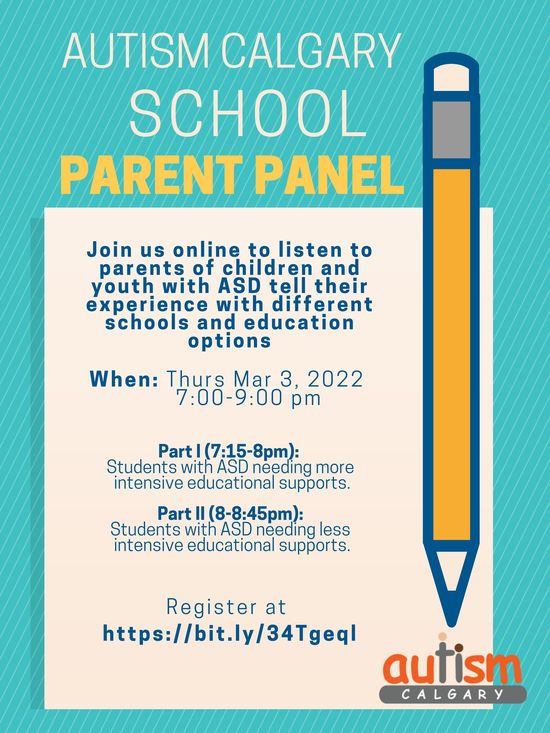
|
|
|
What is Autistic Masking?
Maureen Bennie

From the Autism Awareness Centre Inc. Blog:
Autistic masking, camouflaging, or compensating is a conscious or unconscious suppression of natural autistic responses. It is hiding or controlling behaviours associated with Autism Spectrum Disorder (ASD) that may be viewed as inappropriate in situations. Autistic people may feel the need to present or perform social behaviours that are considered neurotypical or may hide neurodiverse behaviours in order to be accepted and fit in.
An autistic person may mask to avoid being outed or harassed at school or the workplace. It can help a person feel safe from misunderstandings or aggression, but this act of self-preservation takes a toll on self-esteem and self-identity. Masking can contribute to autistic burnout, which occurs when the challenges of life exceed a person’s resources. It can lead to serious physical and mental health problems such as depression and anxiety.
What are the signs of autistic masking?
Masking, a social survival strategy, will look different depending on the individual. Here are some signs of masking behaviour from the Healthline post Autism Masking: To Blend or Not to Blend:
- forcing or faking eye contact during conversations
- imitating smiles and other facial expressions
- mimicking gestures
- hiding or minimizing personal interests
- developing a repertoire of rehearsed responses to questions

- scripting conversations
- pushing through intense sensory discomfort including loud noises
- disguising stimming behaviours (hiding a jiggling foot or trading a preferred movement for one that’s less obvious)
Why does someone mask?
The motivation to mask can happen for a number of reasons such as:
- wanting to blend in and not stand out from the crowd
- to obtain a job, meet the job qualifications, or improve employment opportunities
- concerns about personal safety and well-being (bullying, verbal or emotional attacks, assault, intimidation)
- to increase connections and relationships with others
- to lessen the risk of failure in social situations by using structured techniques, thereby reducing uncertainty and increasing confidence in the ability to socialize
- to avoid discrimination and negative responses from others
What are the negative effects of masking?
Regular masking can have a profound impact on a person’s well-being. Some of the negative effects of masking are:
- exhaustion and fatigue – masking takes a lot of effort
- change in self-perception or self-identity (not feeling like one’s true self, feeling like a “fake”)
- increased stress and anxiety

- depression
- autistic burnout
- a delayed autism diagnosis
- increased risk of experiencing thwarted belongingness and lifetime suicidality
How can we help and support?
The biggest thing we can do is educate ourselves about autism to increase our understanding and acceptance of people who are neurodiverse. No one should have to change who they are to please another person or group. Employers need to learn more about autism in the workplace – there are some good initiatives happening such as Nothing without us – an accessibility strategy for the public service of Canada. Autism training should be a part of every education program. The more we know and understand, the less stigma and pressure autistic people will feel about trying to fit in.
If you want to read an excellent personal viewpoint on masking, please read Judy Endow’s Sucking It Up to Pass as Non-Autistic. Judy says, “I hope more autistics are able to be the person they are, utilizing the supports and accommodations they need, without society insisting they hide their very essence at every turn. I look forward to autistics having everyday lives with things so many take for granted – going to school, being part of the community, having meaningful jobs with living wages along with meaningful relationships. This is the stuff of a satisfying life. All people should have access without society’s requirement of “sucking it up” before a ticket is extended by the majority to those of us in marginalized groups.”
|
|
|
YYC World Autism Awareness Day
YYC World Autism Awareness Day (YYC WAAD) in Calgary has grown to be the largest of its kind in Canada! 2022 marks the 9th annual celebration and we are excited to celebrate in-person again and potentially virtually, raising awareness and acceptance of autism.
Many leading autism/disability agencies and educational institutes, and more will be in attendance. We will have bands and performers, along with all the general public, families with loved ones who have autism, and individuals on the autism spectrum themselves.
Click the posters below to see larger versions.
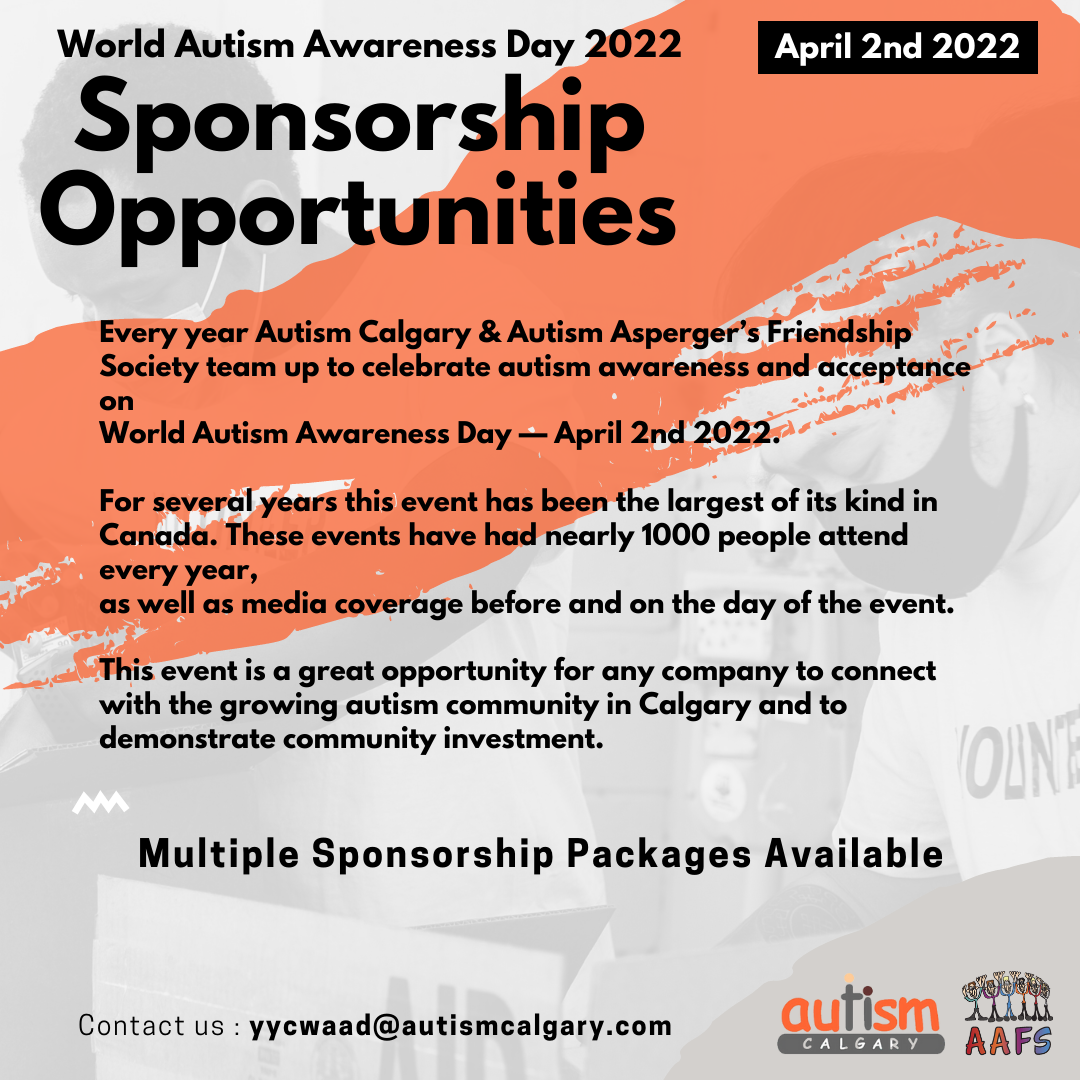 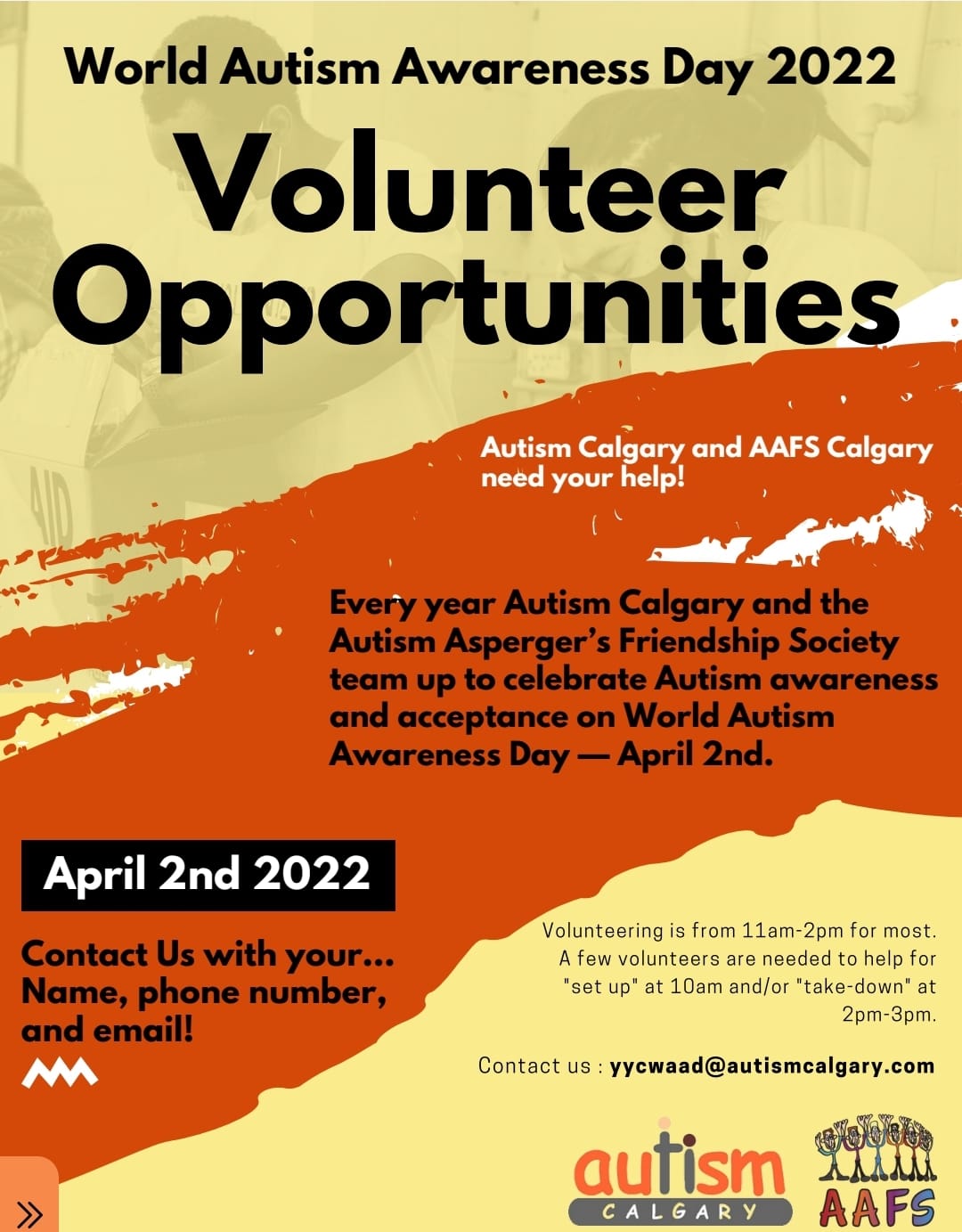
|
|
|
Scripting – Part 1
Carmen Moore
Today I’d like to highlight the evidence-based practice (EBP) of ‘scripting’. Scripting is a strategy used in conjunction with other strategies (as many often are). Throughout this series, we will delve into scripting and how this can work in multiple environments, with multiple goal types. This will be part one of a multi-part series highlighting this one strategy.
Let’s begin at the beginning. What is scripting, anyways? The word may conjure up thoughts of movies or theatre performances, and you are partly correct. Scripts are a support, to help learners sustain or initiate  communication with others, usually through visual or auditory clues. Used properly, scripts can enhance interactions within a home, school, community, or work routines by providing learners with a predetermined script. The connection to a movie or drama script is not that far off, as a script is usually a written set of comments or questions, for the learner to use to interact with a communication partner. communication with others, usually through visual or auditory clues. Used properly, scripts can enhance interactions within a home, school, community, or work routines by providing learners with a predetermined script. The connection to a movie or drama script is not that far off, as a script is usually a written set of comments or questions, for the learner to use to interact with a communication partner.
I have been able to use the practice of scripting in both my personal and professional life. Throughout my series, you may recall my mantra of ‘good for all, critical for some’, and scripting fits right into that mold. I remember helping my husband learn scripts when he was in hotel school, for answering the phones and dealing with issues that customers may have had. I used a script to prepare myself for tough interviews, by practicing answers that I knew should include key components to make sure I was successful. I have also used scripting to help my own child greet people at the door properly, invite them in, and begin to play with ease. It can be as formal as needed to get the outcome you would like to see.
There are many ‘outcomes’ or goals that can be met with this EBP. Some examples of goals are (but are not limited to):
- Engaging in appropriate play scenarios with a peer
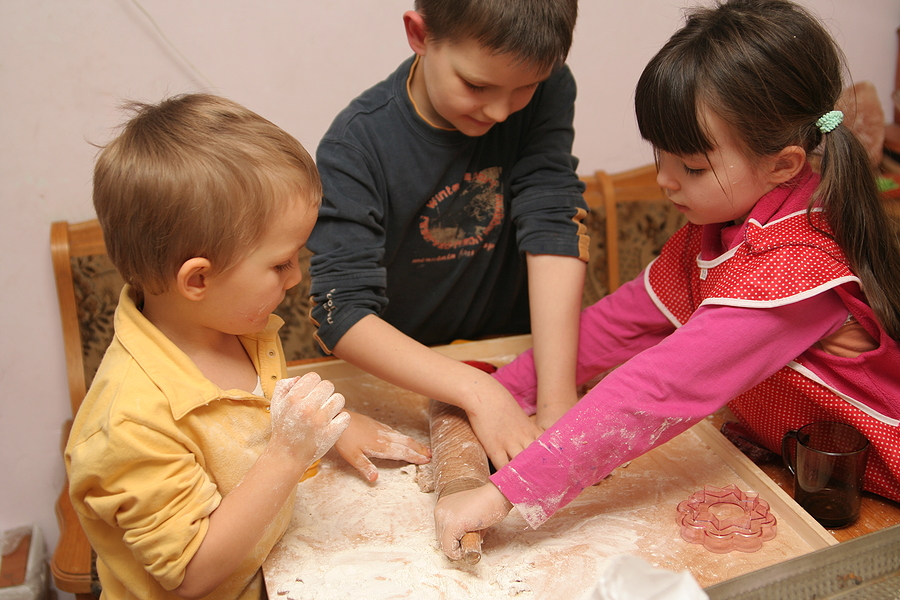
- Initiating interactions
- Describing a problem and requesting assistance
- Making a bid for joint attention
- Making comments and asking questions relevant to the setting/activity
- Conversational speech
- Finding out information needed
Additionally, goals can focus on the generalization of the skill to new communication partners, different settings, or different activities. Teach it in one instance, gain confidence, and then use the skill or conversation in other useful ways or places. For example, if you learn how to order at a certain fast-food restaurant, the learner can use the skill at a sit-down restaurant, or at multiple fast food places with different orders.
There are a lot of ways that scripting can help. I don’t know about you, but I have been involved in some very long conversations about dinosaurs during my life. As much as I actually do love learning about them (I really do), there are some ways that scripting can help with this to expand conversational skills. This strategy can help provide clear expectations about appropriate language, provide relevant questions or comments, increase social behaviour (young to old), improve vocational skills, and help a learner to know how to initiate a conversation or ask for assistance.
What might this look like? Oftentimes, social situations are more difficult, and scripting can be an effective tool to support success. I know for myself, there are certain things I may say or do when entering a group at a table, or a cluster of people at a party or work. Body language can be important, but knowing appropriate verbal ways to enter such a situation can help alleviate anxiety and increase the chance of true engagement.  Again, for all those more introverted people, this may be of benefit before a big social event: good for all, critical for some. Write on a small piece of paper two to three general questions or comments to choose from, as one way to script. The paper (or note on a phone screen) can help support that conversation initiation, and be a visual prompt for the learner that they can use until memorized. Maybe they can practice it beforehand, or have it modeled a few times before they try it out, so that they may (or may not) be able to try without the visual prompt. Again, for all those more introverted people, this may be of benefit before a big social event: good for all, critical for some. Write on a small piece of paper two to three general questions or comments to choose from, as one way to script. The paper (or note on a phone screen) can help support that conversation initiation, and be a visual prompt for the learner that they can use until memorized. Maybe they can practice it beforehand, or have it modeled a few times before they try it out, so that they may (or may not) be able to try without the visual prompt.
Much of the information in this article is from the related AFIRM online module. It is free to sign up for AFIRM here. Next month, part two of this scripting series will look more in-depth at the details of scripting, the steps to take from start to finish, how to fade the prompt, specific points on developing a good script, how to tie with other EBPs to increase the chance of success, and more.
|
|
|
Meet ASA's Family Resource Coordinators
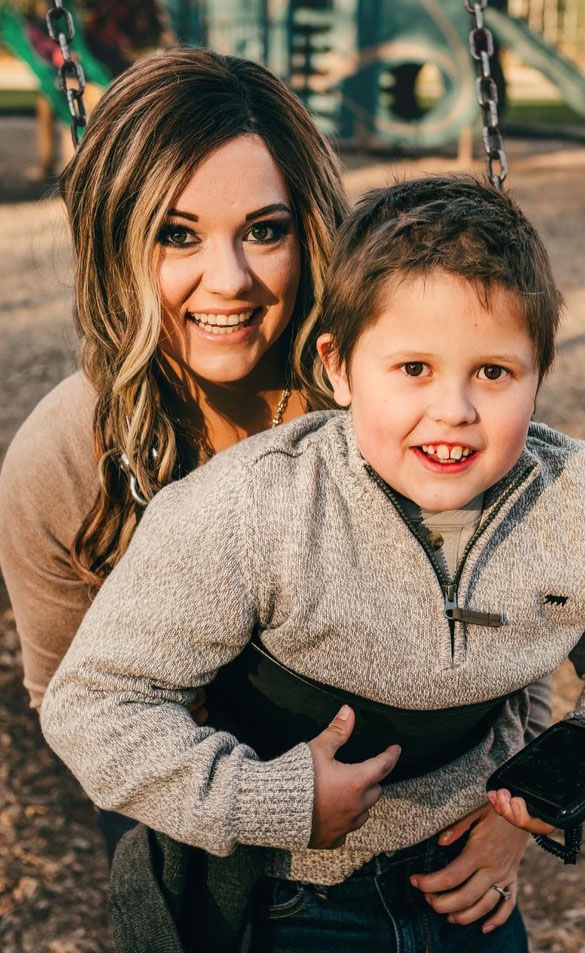
Introducing Brooklyn!
Hello, my name is Brooklyn Martin and I am a Family Resource Coordinator with ASA’s Family Resource Centres. While I’m located in Grande Prairie, I provide support to families across Alberta virtually.
I am a mom to two wonderful boys, ages 8 and 2. My oldest was diagnosed with ASD at the age of 2 and introduced me to a world I am forever grateful for. Connecting with families, hearing their stories and helping them to navigate resources brings so much joy to my life! I look forward to hearing from you!
Find out more about ASA's Family Resource Centres and see their community calendar of presentations here.
|
|
|
|
|